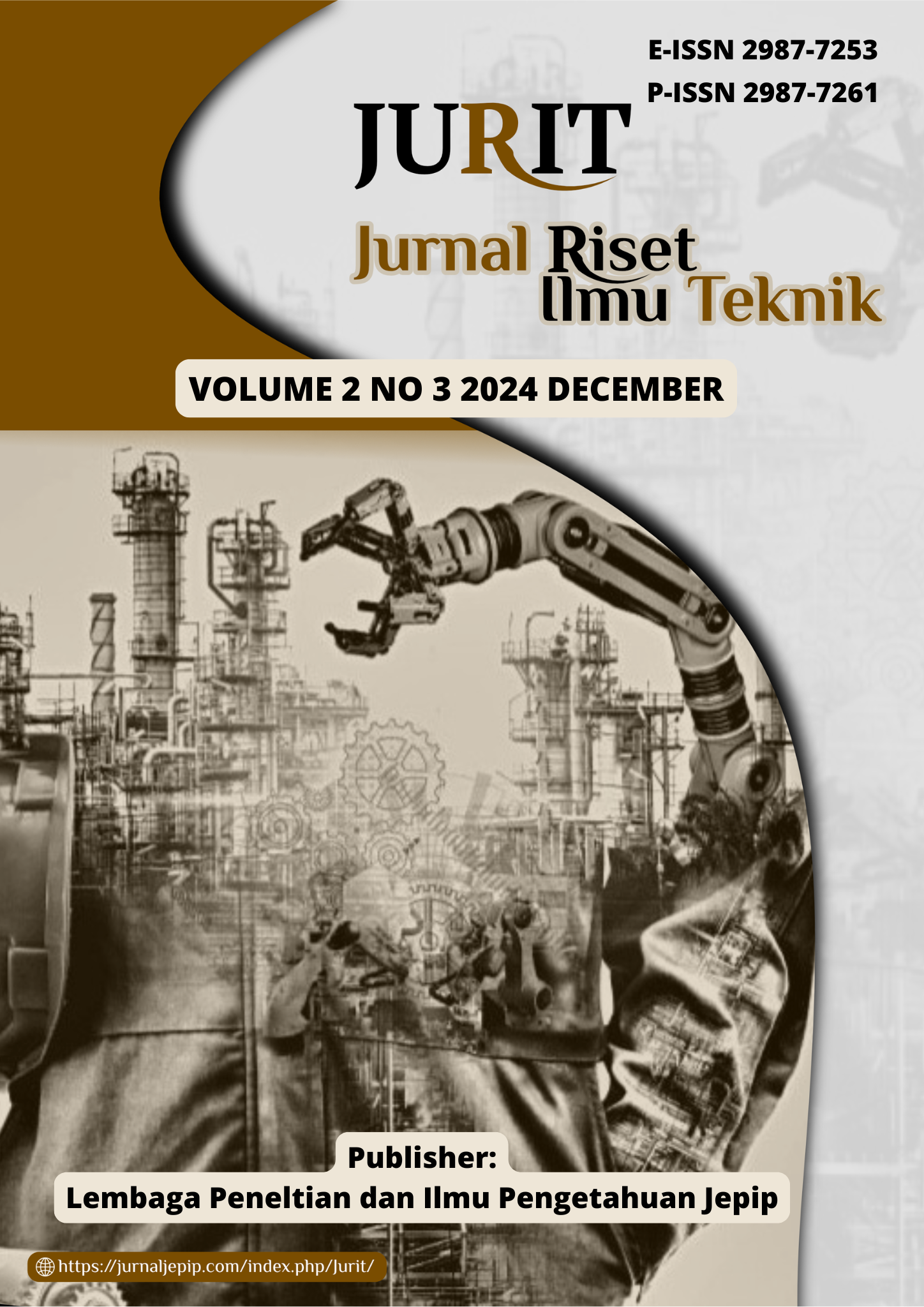A Taguchi-Based Framework for Continuous Quality Improvement in Crude Palm Oil Production
DOI:
https://doi.org/10.59976/jurit.v2i3.134Abstract
Purpose – This study aims to analyze and optimize the quality of Crude Palm Oil (CPO) using the Taguchi method. The research focuses on identifying the dominant factors affecting Free Fatty Acid (FFA), moisture, and impurity content, as well as determining the optimal parameter combination to achieve consistent product quality that meets company standards. Design/methodology/approach – The study employed an experimental design based on the Taguchi method using an orthogonal array with seven factors at two levels. Data were collected from laboratory tests on CPO samples during production, focusing on FFA, moisture, and impurities. Statistical analyses included the Signal-to-Noise Ratio (S/N), Analysis of Variance (ANOVA), and confidence interval validation to identify significant factors and optimal operating conditions. Findings – The results show that factors A (fresh fruit bunch maturity) and F (sterilizer process conditions) significantly influence CPO quality, as indicated by the highest F-ratios (4.64 and 4.86) and contribution values exceeding 15%. The optimal parameter combination successfully minimized variability in FFA and impurity levels, though overall results still slightly exceeded company standards, suggesting the need for stricter control of raw material selection and processing parameters. Confidence interval analysis confirmed that the predicted mean values for FFA, moisture, and impurities were close to the specification limits, indicating potential for further refinement. Originality– This study provides empirical evidence of the Taguchi method’s applicability in the palm oil industry, particularly for improving CPO quality under real industrial constraints. The novelty lies in integrating Taguchi analysis with confidence interval verification to assess compliance robustness, offering a structured framework for continuous process improvement in CPO manufacturing.
References
K. da S. Moreira, “Taguchi design-assisted co-immobilization of lipase A and B from Candida antarctica onto chitosan: Characterization, kinetic resolution application, and docking studies,” Chem. Eng. Res. Des., vol. 177, pp. 223–244, 2022, doi: 10.1016/j.cherd.2021.10.033.
N. Lokesh, “Evaluation on effect of printing process parameter through Taguchi approach on mechanical properties of 3D printed PLA specimens using FDM at constant printing temperature,” 2022. doi: 10.1016/j.matpr.2021.11.054.
M. Heidari-Rarani, “Optimization of FDM process parameters for tensile properties of polylactic acid specimens using Taguchi design of experiment method,” J. Thermoplast. Compos. Mater., vol. 35, no. 12, pp. 2435–2452, 2022, doi: 10.1177/0892705720964560.
M. N. Ahmad, “Application of Taguchi Method to Optimize the Parameter of Fused Deposition Modeling (FDM) Using Oil Palm Fiber Reinforced Thermoplastic Composites,” Polymers (Basel)., vol. 14, no. 11, 2022, doi: 10.3390/polym14112140.
R. Aniza, “Integrating Taguchi method and artificial neural network for predicting and maximizing biofuel production via torrefaction and pyrolysis,” Bioresour. Technol., vol. 343, 2022, doi: 10.1016/j.biortech.2021.126140.
J. S. Pan, “Maximum power point tracking and parameter estimation for multiple-photovoltaic arrays based on enhanced pigeon-inspired optimization with Taguchi method,” Energy, vol. 251, 2022, doi: 10.1016/j.energy.2022.123863.
W. H. Chen, “A comprehensive review of thermoelectric generation optimization by statistical approach: Taguchi method, analysis of variance (ANOVA), and response surface methodology (RSM),” 2022. doi: 10.1016/j.rser.2022.112917.
S. P. Arunkumar, “Taguchi optimization of metal inert gas (MIG) welding parameters to withstand high impact load for dissimilar weld joints,” Mater. Today Proc., pp. 1411–1417, 2022, doi: 10.1016/j.matpr.2021.11.619.
W. H. Chen, “Optimization of a vertical axis wind turbine with a deflector under unsteady wind conditions via Taguchi and neural network applications,” Energy Convers. Manag., vol. 254, 2022, doi: 10.1016/j.enconman.2022.115209.
R. Hasanzadeh, “Biomass and low-density polyethylene waste composites gasification: Orthogonal array design of Taguchi technique for analysis and optimization,” Int. J. Hydrogen Energy, vol. 47, no. 67, pp. 28819–28832, 2022, doi: 10.1016/j.ijhydene.2022.06.244.
O. Najm, “Optimization of alkali-activated ladle slag composites mix design using taguchi-based TOPSIS method,” Constr. Build. Mater., vol. 327, 2022, doi: 10.1016/j.conbuildmat.2022.126946.
M. Kam, “Investigation of the effect of FDM process parameters on mechanical properties of 3D printed PA12 samples using Taguchi method,” J. Thermoplast. Compos. Mater., vol. 36, no. 1, pp. 307–325, 2023, doi: 10.1177/08927057211006459.
C. P. Jiang, “Optimization of FDM 3D printing parameters for high strength PEEK using the Taguchi method and experimental validation,” Rapid Prototyp. J., vol. 28, no. 7, pp. 1260–1271, 2022, doi: 10.1108/RPJ-07-2021-0166.
O. A. Falowo, “A novel heterogeneous catalyst synthesis from agrowastes mixture and application in transesterification of yellow oleander-rubber oil: Optimization by Taguchi approach,” Fuel, vol. 312, 2022, doi: 10.1016/j.fuel.2021.122999.
B. Niu, “Multi-objective optimization of supply air jet enhancing airflow uniformity in data center with Taguchi-based grey relational analysis,” Build. Environ., vol. 208, 2022, doi: 10.1016/j.buildenv.2021.108606.
N. Rahman, “Graphene oxide/Mg-Zn-Al layered double hydroxide for efficient removal of doxycycline from water: Taguchi approach for optimization,” J. Mol. Liq., vol. 354, 2022, doi: 10.1016/j.molliq.2022.118899.
C. A. Mbachu, “Green synthesis of iron oxide nanoparticles by Taguchi design of experiment method for effective adsorption of methylene blue and methyl orange from textile wastewater,” Results Eng., vol. 19, 2023, doi: 10.1016/j.rineng.2023.101198.
Z. Zhang, “Utilization of hydrogen-diesel blends for the improvements of a dual-fuel engine based on the improved Taguchi methodology,” Energy, vol. 292, 2024, doi: 10.1016/j.energy.2024.130474.
T. Sathish, “Investigations on influences of MWCNT composite membranes in oil refineries waste water treatment with Taguchi route,” Chemosphere, vol. 298, 2022, doi: 10.1016/j.chemosphere.2022.134265.
B. E. Yuce, “The use of Taguchi, ANOVA, and GRA methods to optimize CFD analyses of ventilation performance in buildings,” Build. Environ., vol. 225, 2022, doi: 10.1016/j.buildenv.2022.109587.
X. Huang, “Optimization of melting performance of a heat storage tank under rotation conditions: Based on taguchi design and response surface method,” Energy, vol. 271, 2023, doi: 10.1016/j.energy.2023.127100.
D. Deng, “Multi-response optimization of laser cladding for TiC particle reinforced Fe matrix composite based on Taguchi method and grey relational analysis,” Opt. Laser Technol., vol. 153, 2022, doi: 10.1016/j.optlastec.2022.108259.
S. H. Thimmaiah, “An artificial neural network and Taguchi prediction on wear characteristics of Kenaf–Kevlar fabric reinforced hybrid polyester composites,” Polym. Compos., vol. 44, no. 1, pp. 261–273, 2023, doi: 10.1002/pc.27043.
J. John, “Optimization of 3D printed polylactic acid structures with different infill patterns using Taguchi-grey relational analysis,” Adv. Ind. Eng. Polym. Res., vol. 6, no. 1, pp. 62–78, 2023, doi: 10.1016/j.aiepr.2022.06.002.
N. Maguluri, “Assessing the effect of FDM processing parameters on mechanical properties of PLA parts using Taguchi method,” J. Thermoplast. Compos. Mater., vol. 36, no. 4, pp. 1472–1488, 2023, doi: 10.1177/08927057211053036.
B. Omidi, “Performance evaluation of a solar desalination-hot water system using heat pipe vacuum tube parabolic trough solar collector – An experimental study with Taguchi analysis,” Energy Convers. Manag., vol. 292, 2023, doi: 10.1016/j.enconman.2023.117347.
N. Praveen, “Synthesis and Wire EDM Characteristics of Cu–Al–Mn Ternary Shape Memory Alloys Using Taguchi Method,” J. Inst. Eng. India Ser. D, vol. 105, no. 2, pp. 1187–1200, 2024, doi: 10.1007/s40033-023-00501-x.
W. D. Lestari, “Optimization of 3D printed parameters for socket prosthetic manufacturing using the taguchi method and response surface methodology,” Results Eng., vol. 21, 2024, doi: 10.1016/j.rineng.2024.101847.
M. A. Khan, “Application of a hybrid Taguchi grey approach for determining the optimal parameters on wire electrical discharge machining of Ti6Al4V,” Int. J. Interact. Des. Manuf., vol. 18, no. 5, pp. 3059–3076, 2024, doi: 10.1007/s12008-023-01440-3.
J. S. Chohan, “Optimization of FDM Printing Process Parameters on Surface Finish, Thickness, and Outer Dimension with ABS Polymer Specimens Using Taguchi Orthogonal Array and Genetic Algorithms,” Math. Probl. Eng., vol. 2022, 2022, doi: 10.1155/2022/2698845.
G. Gao, “Parametric Optimization of FDM Process for Improving Mechanical Strengths Using Taguchi Method and Response Surface Method: A Comparative Investigation,” Machines, vol. 10, no. 9, 2022, doi: 10.3390/machines10090750.
P. Chokkalingam, “Development and characterization of ceramic waste powder-slag blended geopolymer concrete designed using Taguchi method,” Constr. Build. Mater., vol. 349, 2022, doi: 10.1016/j.conbuildmat.2022.128744.
M. Hussein, “Sustainable Logistics Planning in Modular Integrated Construction Using Multimethod Simulation and Taguchi Approach,” J. Constr. Eng. Manag., vol. 148, no. 6, 2022, doi: 10.1061/(ASCE)CO.1943-7862.0002273.
A. M. Krishnan, “Evaluation of mechanical strength of the stir casted aluminium Metal matrix composites (AMMCs) using Taguchi method,” Mater. Today Proc., vol. 62, pp. 1943–1946, 2022, doi: 10.1016/j.matpr.2022.02.036.
A. Jain, “Application of hybrid Taguchi L16 and desirability for model prediction and optimization in assessment of the performance of a novel Water Hyacinth biodiesel run diesel engine,” Fuel, vol. 339, 2023, doi: 10.1016/j.fuel.2022.127377.
M. Saravanan, “Optimization of Quench Polish Quench (QPQ) Coating Process Using Taguchi Method,” 2022. doi: 10.4028/p-z569vy.
S. Karumuri, “Multi-objective optimization using Taguchi based grey relational analysis in friction stir welding for dissimilar aluminium alloy,” Int. J. Interact. Des. Manuf., vol. 18, no. 3, pp. 1627–1644, 2024, doi: 10.1007/s12008-023-01529-9.
W. Yang, “Taguchi optimization and thermoelectrical analysis of a pin fin annular thermoelectric generator for automotive waste heat recovery,” Renew. Energy, vol. 220, 2024, doi: 10.1016/j.renene.2023.119628.
S. Raja, “Development and experimental analysis of polymer based composite bipolar plate using Aquila Taguchi optimization: Design of experiments,” Polym. Compos., vol. 43, no. 8, pp. 5522–5533, 2022, doi: 10.1002/pc.26861.
Downloads
Published
How to Cite
Issue
Section
License
Copyright (c) 2024 Tengku Khoirunnisa, Chellcia Mutiara Iwfanka, Melkisedek Gumi

This work is licensed under a Creative Commons Attribution 4.0 International License.





















